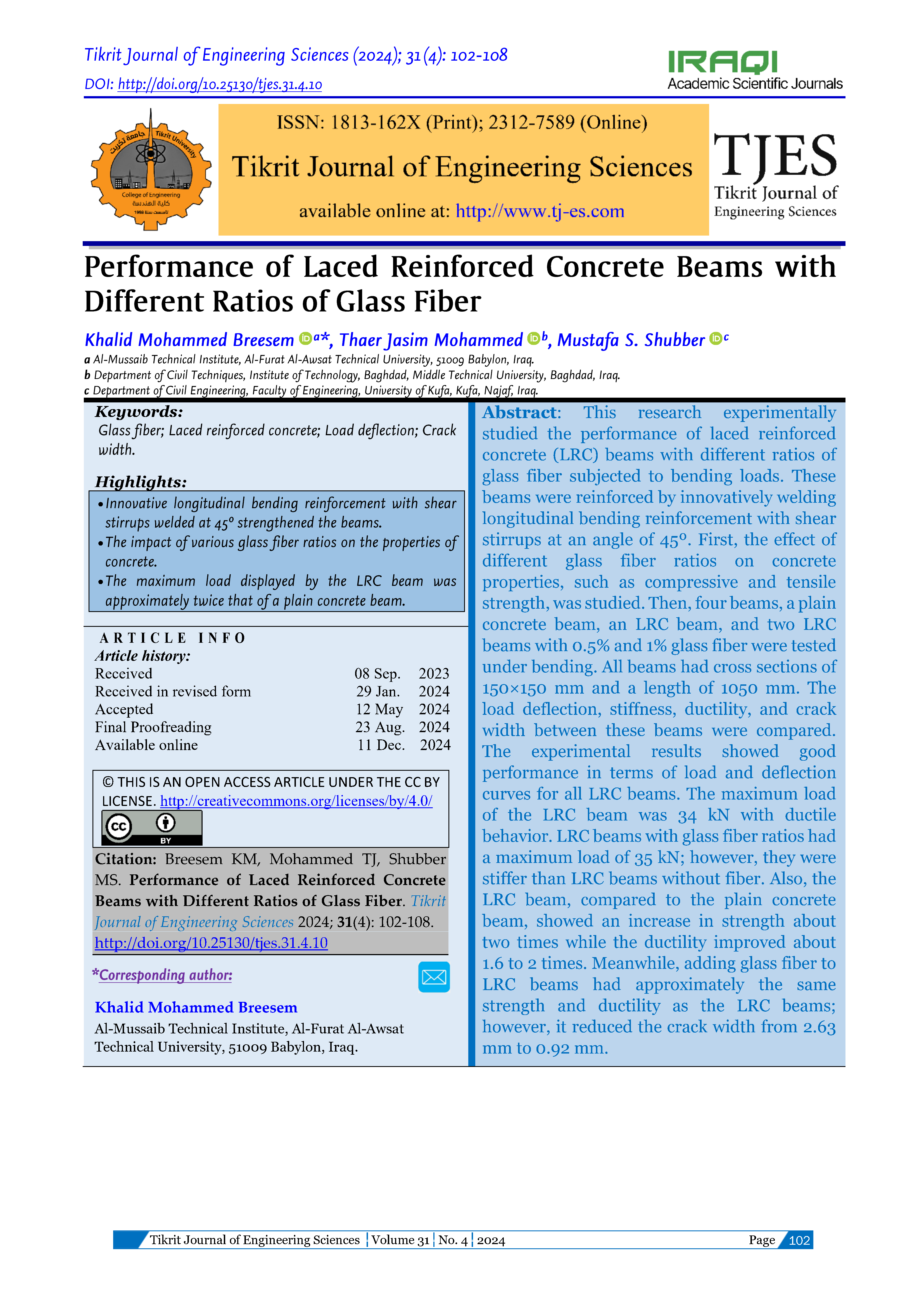Performance of Laced Reinforced Concrete Beams with Different Ratios of Glass Fiber
Main Article Content
Abstract
This research experimentally studied the performance of laced reinforced concrete (LRC) beams with different ratios of glass fiber subjected to bending loads. These beams were reinforced by innovatively welding longitudinal bending reinforcement with shear stirrups at an angle of 45º. First, the effect of different glass fiber ratios on concrete properties, such as compressive and tensile strength, was studied. Then, four beams, a plain concrete beam, an LRC beam, and two LRC beams with 0.5% and 1% glass fiber were tested under bending. All beams had cross sections of 150×150 mm and a length of 1050 mm. The load deflection, stiffness, ductility, and crack width between these beams were compared. The experimental results showed good performance in terms of load and deflection curves for all LRC beams. The maximum load of the LRC beam was 34 kN with ductile behavior. LRC beams with glass fiber ratios had a maximum load of 35 kN; however, they were stiffer than LRC beams without fiber. Also, the LRC beam, compared to the plain concrete beam, showed an increase in strength about two times while the ductility improved about 1.6 to 2 times. Meanwhile, adding glass fiber to LRC beams had approximately the same strength and ductility as the LRC beams; however, it reduced the crack width from 2.63 mm to 0.92 mm.
Metrics
Article Details

This work is licensed under a Creative Commons Attribution 4.0 International License.
THIS IS AN OPEN ACCESS ARTICLE UNDER THE CC BY LICENSE http://creativecommons.org/licenses/by/4.0/
Plaudit
References
Allawi AA, Shubber AN, Al Gharawi M, El-Zohairy A, Ibrahim TH, Al-Ahmed AHA, Arafa IT. Enhancement of RC T‐Beams Toughness Using Laced Stirrups Reinforcement for Blast Response Predictions. Structural Concrete 2023; 24(3): 3839-3856. DOI: https://doi.org/10.1002/suco.202200894
Sai Venkata Ramanjaneyulu V, Papa Rao G. Behaviour of RC Structural Elements with Laced Reinforcement. Recent Advances in Structural Engineering 2019; Springer, Singapore: 817-826. DOI: https://doi.org/10.1007/978-981-13-0362-3_66
Sudharsan N, Grant CB, Murthi P, Poongodi K, Kumar PM. A Comparative Experimental Investigation on Laced Reinforced Concrete Beam and Conventional Beam under Monotonic Loading. International Conference on Contemporary and Sustainable Infrastructure 21-22 May 2021; Bangalore, India: p. 1-8. DOI: https://doi.org/10.1088/1755-1315/822/1/012034
Allawi AA. Flexural Performance of Laced Reinforced Concrete Beams under Static and Fatigue Loads. Journal of Engineering 2019; 25(10): 134-153. DOI: https://doi.org/10.31026/j.eng.2019.10.10
Kareem A, Mohammed SD. The Experimental and Theoretical Effect of Fire on the Structural Behavior of Laced Reinforced Concrete Deep Beams. Engineering, Technology & Applied Science Research 2023; 13(5): 11795-11800. DOI: https://doi.org/10.48084/etasr.6272
Nilimaa J. Smart Materials and Technologies for Sustainable Concrete Construction. Developments in the Built Environment 2023; 25: 100177, (1-19). DOI: https://doi.org/10.1016/j.dibe.2023.100177
Gan S, Chen RS, Padzil FN, Moosavi S, Mou’ad AT, Loh SK, Idris Z. Potential Valorization of Oil Palm Fiber in Versatile Applications Towards Sustainability: A Review. Industrial Crops and Products 2023; 199:116763. DOI: https://doi.org/10.1016/j.indcrop.2023.116763
Shah AA, Ribakov Y. Recent Trends in Steel Fibered High-Strength Concrete. Materials & Design 2011; 32(8-9):4122-51. DOI: https://doi.org/10.1016/j.matdes.2011.03.030
Singh N, Hui D, Singh R, Ahuja IP, Feo L, Fraternali F. Recycling of Plastic Solid Waste: A State of Art Review and Future Applications. Composites Part B: Engineering 2017; 115:409-422. DOI: https://doi.org/10.1016/j.compositesb.2016.09.013
Haq IU, Elahi A, Nawaz A, Shah SA, Ali K. Mechanical and Durability Performance of Concrete Mixtures Incorporating Bentonite, Silica Fume, and Polypropylene Fibers. Construction and Building Materials 2022; 345:128223. DOI: https://doi.org/10.1016/j.conbuildmat.2022.128223
I.Q.S. Iraqi Standard Specification for Portland Cement. No. 5/ 2019.
I.Q.S. Iraqi Standard Specification for Aggregate form Natural Sources for Concrete and Building Construction. 1984: p. 11.
Srinivasa Rao P, Sarma BS, Lakshmanan N, Stangenberg F. Seismic Behavior of Laced Reinforced Concrete Beams. Eleventh World Conference on Earthquake Engineering 1996; Acapulco, Mexico: p. 1-8.
Allawi AA, Shubber AN. Behavior of Laced Reinforced Concrete Beam under Static Load. Journal of Engineering and Sustainable Development 2017; 21(3):189-201.
Luo G, Li W, Liang W, Liu G, Ma Y, Niu Y, Li G. Coupling Effects of Glass Fiber Treatment and Matrix Modification on the Interfacial Microstructures and the Enhanced Mechanical Properties of Glass Fiber/Polypropylene Composites. Composites Part B: Engineering 2017; 111:190-199. DOI: https://doi.org/10.1016/j.compositesb.2016.12.016
ASTM C43-143. Standard Test Method for Slump of Hydraulic-Cement Concrete. ASTM International 2003.
ASTM C 496. Standard Test Method for Splitting Tensile Strength of Cylindrical Concrete Specimens. Annual Book of ASTM Standards 2003; 04(02): 259-262.
Ahmad J, González-Lezcano RA, Majdi A, Ben Kahla N, Deifalla AF, El-Shorbagy MA. Glass Fibers Reinforced Concrete: Overview on Mechanical, Durability and Microstructure Analysis. Materials 2022; 15(15):5111, (1-23). DOI: https://doi.org/10.3390/ma15155111





